#c: bly
Text

2 notes
·
View notes
Note
18,22, 29
22:A song that moves you forward
THE SOUNDTRACK OF CURRY QUEST but it's mostly because of the content of the episode. Hurts Like Heaven by Coldplay is cute too (the entirety of Mylo Xyloto is beautiful tbh (and A Head Full Of Dreams too)), Descend by Toby Fox (for Homestuck) and Dinner Is Not Over by Jack Stauber
29:A song that you remember from your childhood
HEHEHEH Guararé by Chico Trujillo was one of my favorites when we played cumbia at family reunions! also Cannabis by Ska-p or Me Voy by Julieta Venegas
#¡ know ¡t's meant to be only one song but pls ¡ couldnt poss¡bly choose just one ¡m a l¡bra😭😭#asks#Be my beloved#mus¡c ask game#d¡nner ¡s not over m¡ght conta¡n sens¡t¡ve top¡cs
2 notes
·
View notes
Text
Testa vad du kan om grundämnen!
Vad innehöll luftskeppet Hindenburg?
Det här luftskeppet brann upp en gång i tiden. Innehållet i det var ett grundämne. Men vilket?
Få reda på det rätta svaret på Cajram Quiz!
Cajram Quiz finns på www.cajram.se.
View On WordPress
#ag#argentum#au#aurum#bly#c#grundämnen#guld#helium#järn#kol#periodiska systemet#plutonium#silver#syre#uran#väte
1 note
·
View note
Text

Juan Ramón Jiménez, tr by Robert Bly, from "Nocturne" wr. c. 1903
2K notes
·
View notes
Text
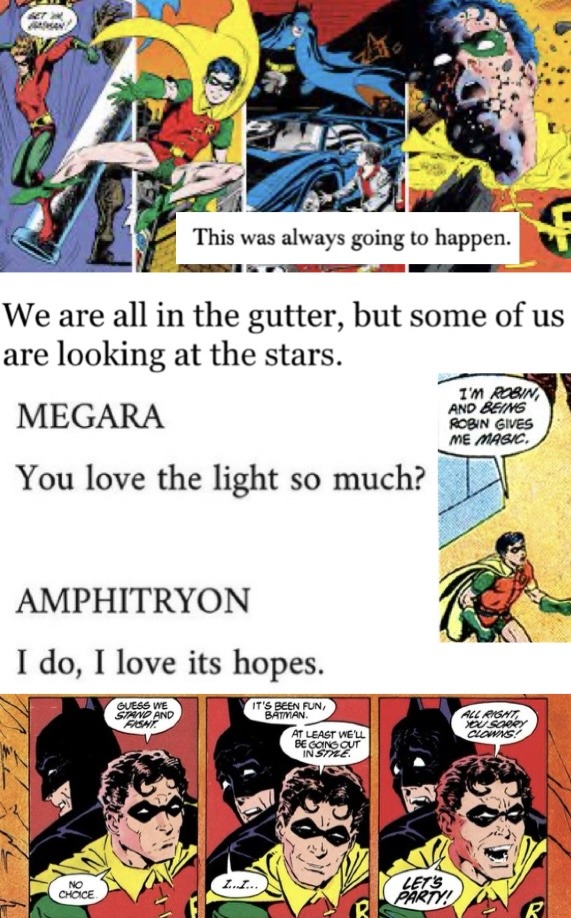
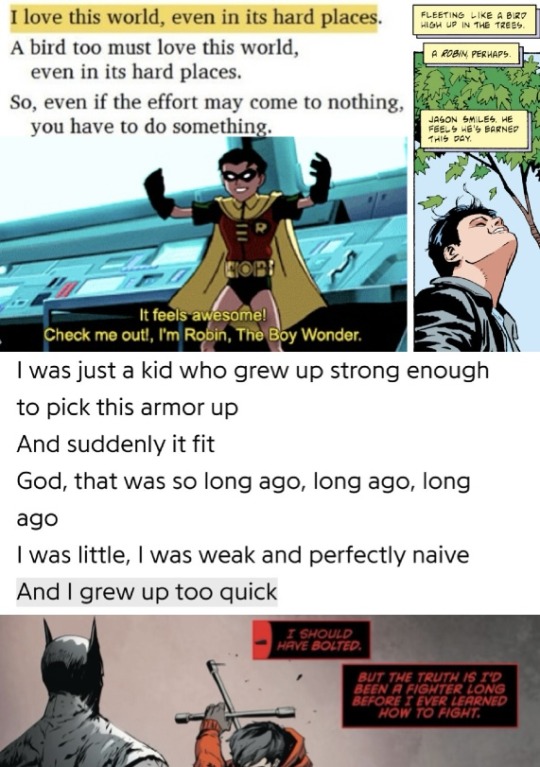




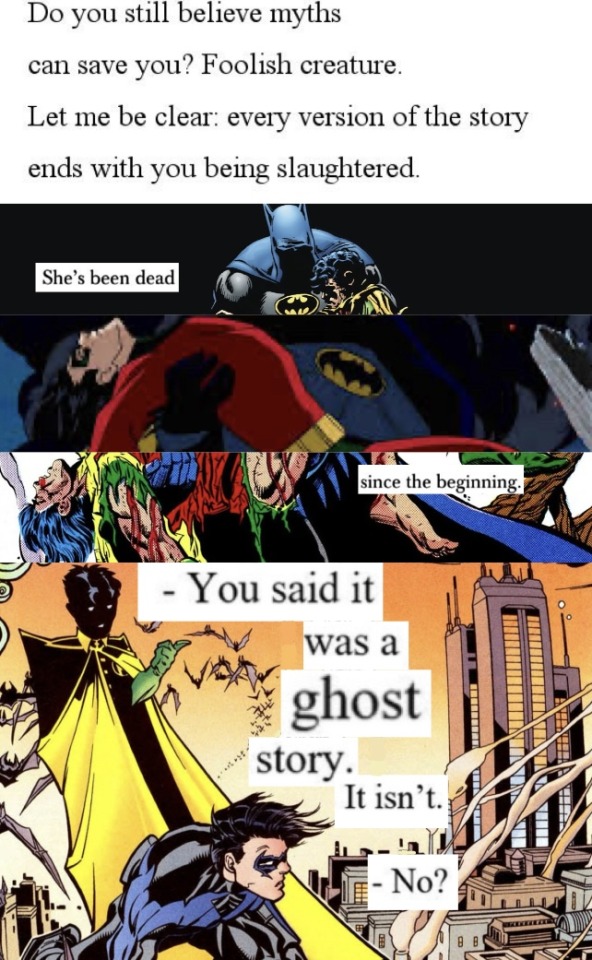
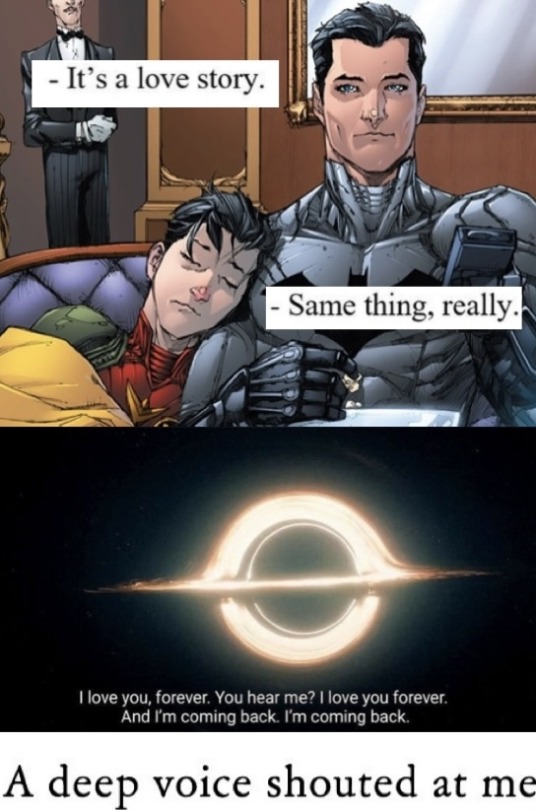

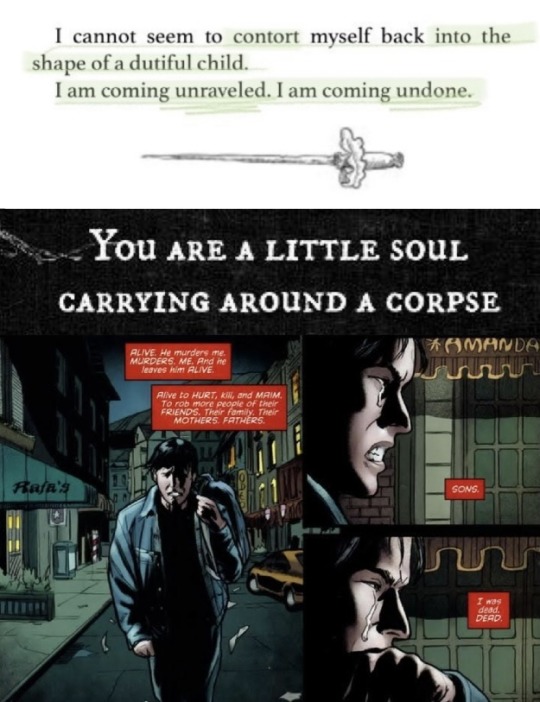
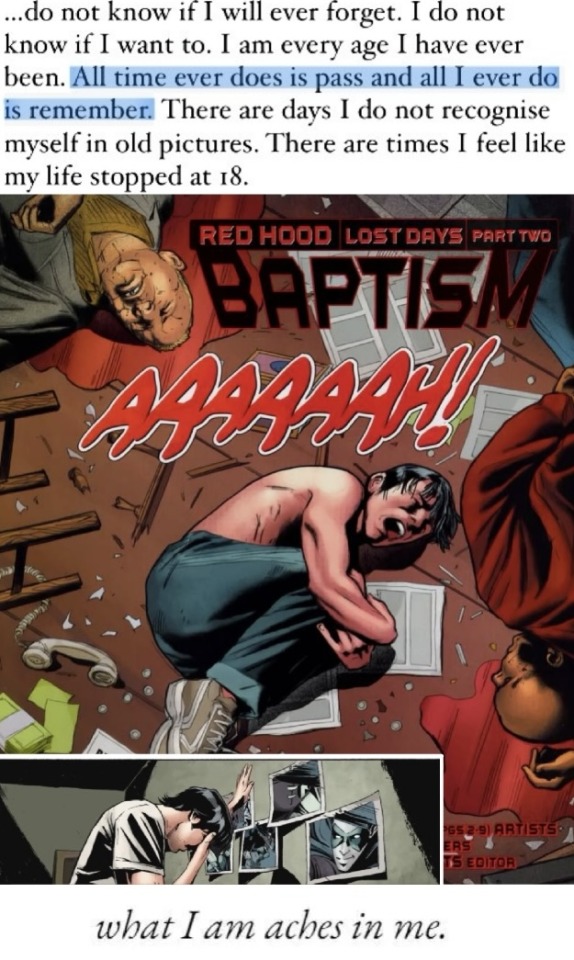

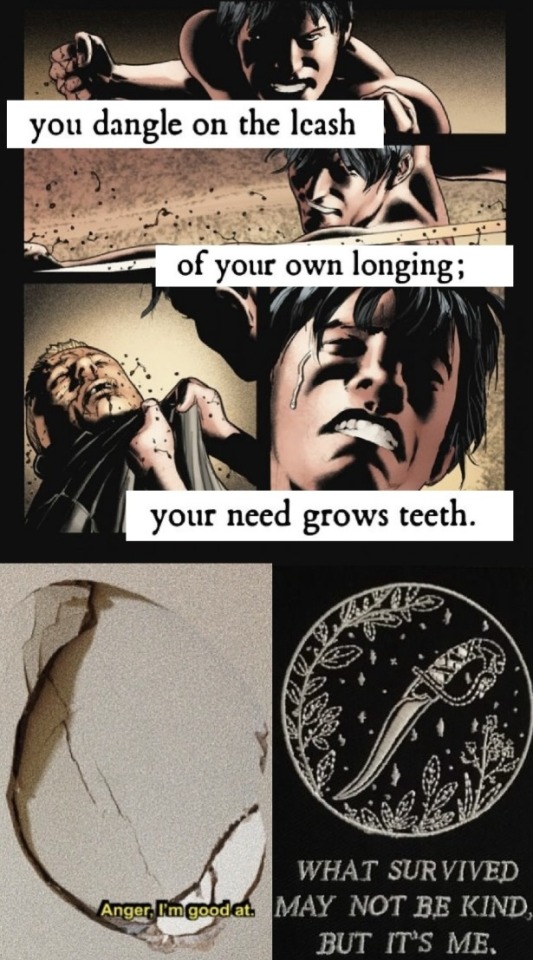

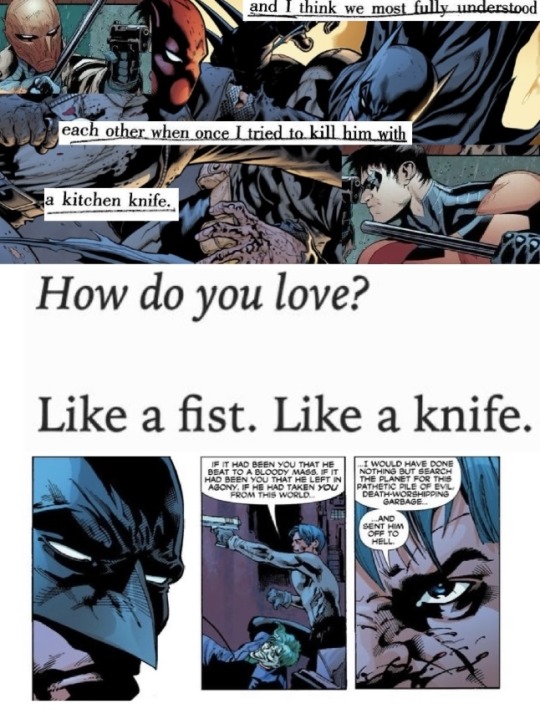
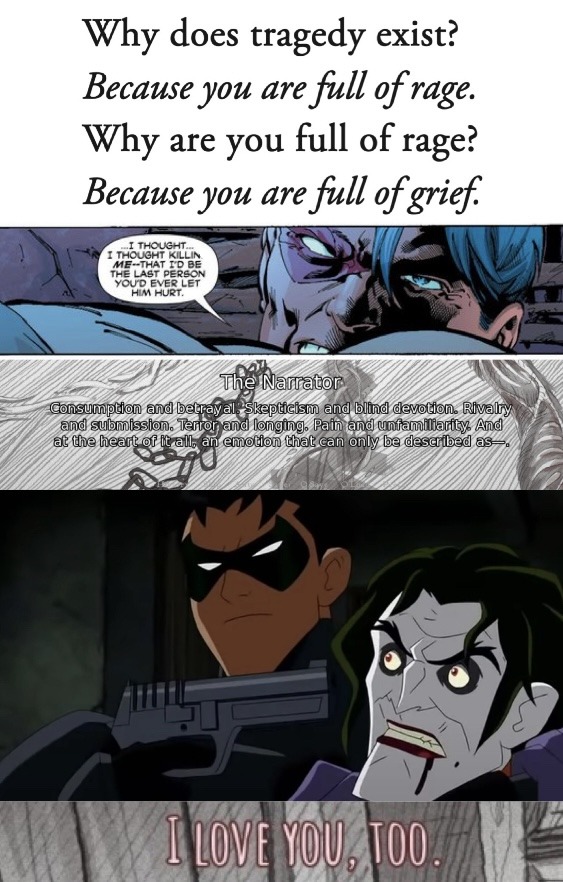
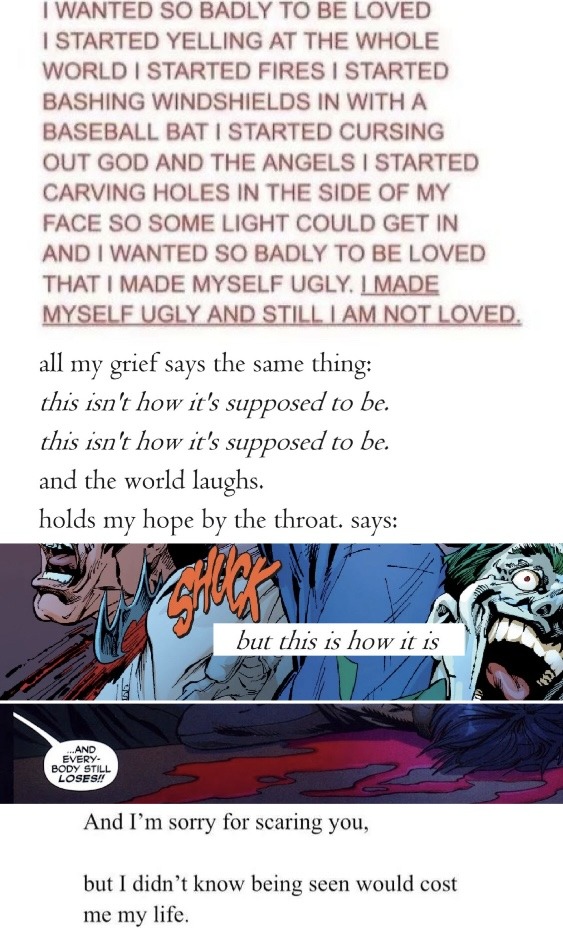

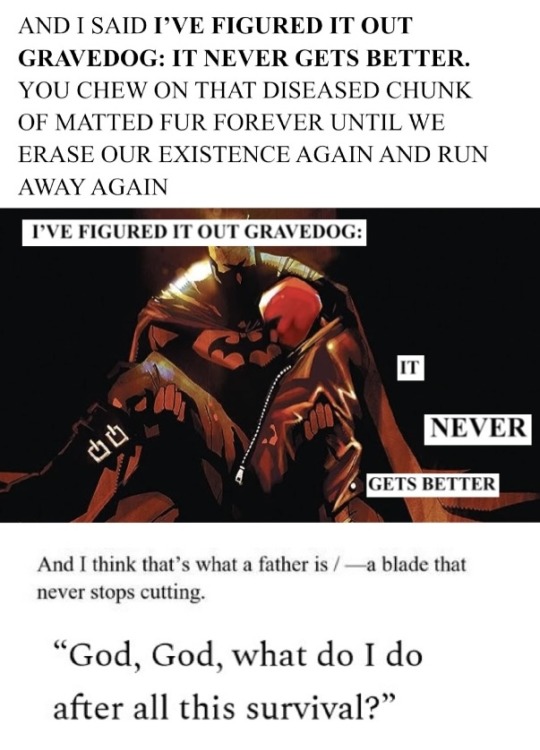

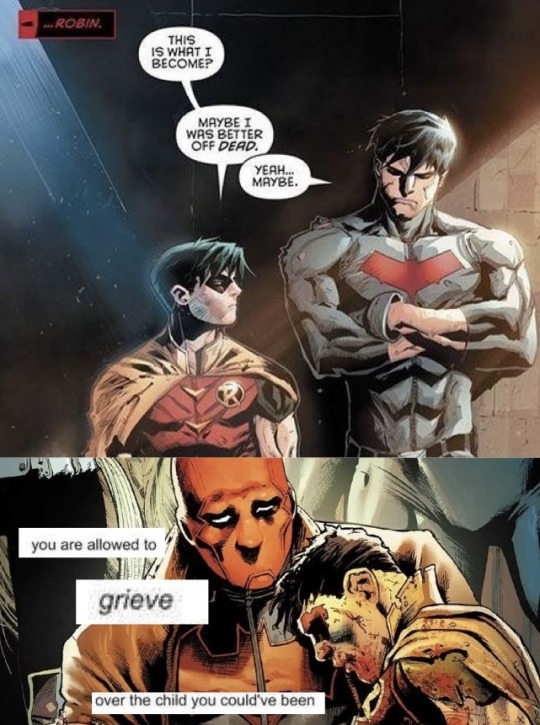



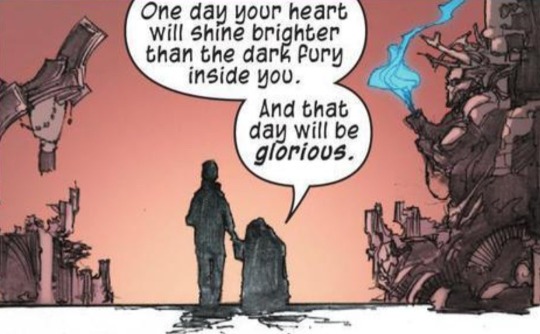


Jason (from the Greek Iásōn, “healer”) Peter Todd (from the German Tod, “death”) - I hope you find your way out of that grave.
dc comics + The Oresteia, Aeschylus / Lady Windermere’s Fan, Oscar Wilde / Grief Lessons: Four Plays [tr. Anne Carson], Euripides + Batman v1 #385 / Batman: The Cult #3 / For Example, Mary Oliver / Batman: Legends of The Dark Knight #100 / Batman: Under the Red Hood / Eight, Sleeping at Last / Red Hood and the Outlaws: Rebirth / Batman: Urban Legends #10 + ? / On Earth We’re Briefly Gorgeous, Ocean Vuong / Red Hood and The Outlaws #25 / Slay the Princess / pinterest + Batman #422 / Batman #424 + Rilke's Book of Hours: Love Poems to God, Rainer Maria Rilke + Batman #428 | A Death in the Family / @/metamorphesque, tumblr / American Teenager, Ethel Cain / Anecdote of the Pig, Tory Adkisson / interpretations of A Death in the Family + The Oresteia, Aeschylus / Nightwing: Secret Files and Origins #1 + the Haunting of Bly Manor + Red Hood and the Outlaws #23 / @/petrichara, tumblr / I Didn't Apologize to the Well, Mahmoud Darwish / Infinite Crisis: Secret Files + pinterest / Ruin and Rising, Leigh Bardugo / Red Hood and the Outlaws #26 / The Cruel Prince, Holly Black / pinterest / Red Hood: The Lost Days / Sue Zhao / Red Hood: The Lost Days part II + Red Hood: The Lost Days #4 / I See Boats Moving, Fernando Pessoa / Oedipus the King, TV Tropes / @/devilsmoon, tumblr / Red Hood: The Lost Days + Speeches for Dr Frankenstein, Margaret Atwood / Saving June, Hannah Arrington + embroidered patch / Slay the Princess / unaligned, @/hamletmaschine + Batman: Under the Red Hood / Batman: Under the Red Hood + Batman and Robin #11 + South and West: From a Notebook, Joan Didion / The Good Fight, Ada Limón / Batman: Under the Red Hood / Grief Lessons: Four Plays, Euripides [tr. Anne Carson] / Batman: Under the Red Hood / Slay the Princess / Under the Red Hood / Slay the Princess / @/sainticide, twitter / The Truth About Grief, Fortesa Latifi + Batman: Under the Red Hood / Batman: Under the Red Hood / Ten Legs, Eight Broken, mandana on tiktok / War of the Foxes, Richard Siken + Under the Red Hood + Batman #428 | A Death in the Family / The Unabridged Journals Of Sylvia Plath, Sylvia Plath / Under the Red Hood + Batman #428 | A Death in the Family / @baitmeat, tumblr + Batman: Under the Red Hood (Deluxe Edition) / Origin Story, Desireé Dallagiacomo / Vive, Vive, Traci Brimhall / The Dogs I Have Kissed, Trista Mateer + Batman: Under the Red Hood + Three Jokers / Red Hood and the Outlaws Rebirth #9 / @/sainticide, twitter + Red Hood and the Outlaws #10 / Would’ve, Could’ve, Should’ve, Taylor Swift / ? + Robin 80th Anniversary 100 Page Super Spectacular / Ep. 4: Joseph Campbell and the Power of Myth -- 'Sacrifice and Bliss', Joseph Campbell / White Knight #7 + Heaven, Mieko Kawakami / Forest Fire, Mitski / Red Hood and the Outlaws Vol. 2 #9 + Batman Annual #25 + Free Will Astrology, Rob Brezsny / Letter XV, @/lucidloving / Red Hood and the Outlaws Vol 1: REDemption / briscoepark + The Civil War, Anne Sexton [compiled by @/lovejoyparadox here] / @/soapstore, tumblr + I Await the Devil’s Coming, Mary MacLane + Claire C. Holland / @/havingrevelations, tumblr / Meditations in an Emergency, Cameron Awkward-Rich + Deathstroke #34 / Grief Lessons: Four Plays by Euripides [tr. Anne Carson] + Red Hood and the Outlaws
#Jason todd#batman#batfam#bruce wayne#web weaving#dick grayson#robin#dc comics#also all love quotes are platonic please do not ship!#also whoever kept putting slay the Princess on my dash I owe you my life
183 notes
·
View notes
Text
1 like and i'll explain my entire gar restructure headcanon (part 1)

THANKS TESSA ILYYYYYYY
okay so as i'm sure you've seen everyone and their mother in this fandom say, 1.2 million soldiers for an INTERGALACTIC WAR is nowhere near enough. i mean, look at the top ten largest armies in the world this year.

by canon explanation, the GAR is smaller than the standing army of a country with 23 million people living in it. you know how many people live on coruscant? three trillion (and that number should be way way way higher to match the population density we're shown, but let's not get into that.) so, because that is stupid, i've gone the route of what someone suggested on wookiepedia one time: that a unit refers to a standard group of soldiers.
It is also possible that Lama Su did not intend the term "unit" to refer to an individual soldier. If a "unit" referred to a battalion of 576 troopers (as Lama Su spoke of later in Obi-Wan's visit), then 200,000 of these would render 115,200,000 clones and the 1,000,000 others spoken of as 576,000,000. This grand total of 691,200,000 would be far more suitable for the core of a galactic army. A "unit" being a 2,304-clone regiment, the largest military division classified as a unit instead of a formation, would amount to 2,764,800,000 clones. Furthermore, if a "unit" refers to a legion, the closest formation in size to a real-life British division of 15,000 men, the 1,200,000 units would have more than 18,000,000,000 clones, a truly "grand" army, suitable for defeating the huge numbers of droids under the Confederacy.
this scared me, because 18 billion people created purely for the purpose of serving in an army kind of broke my brain, so i settled for a nice round 1 billion, which is tbh way too low, so i Will also include the numbers for an army of 18 billion.
Structure of systems army if GAR = 1 billion (numbers, units, and clone+jedi officers) (if you use these in your fic or art, please credit my tumblr)
at this point i cant remember what is and isn't canon, because i created this two years ago. however, i'm pretty sure i invented most of it using vaguely equivalent military terms, because canon is Stupid.
Squad:
15 soldiers
corporal
Patrol:
75 soldiers (5 squads)
sergeant (5 corporals, 1 sergeant)
Echelon:
375 soldiers (5 patrols)
sergeant-major (25 corporals, 5 sergeants, 1 sergeant-major)
Platoon:
5 625 soldiers (15 echelons)
lieutenant (375 corporals, 25 sergeants, 15 sergeant-majors, 1 lieutenant)
Company:
28 125 soldiers (5 platoons)
captain (also a rank awarded to high ranking medics/chief medical officers) (1 875 corporals, 125 sergeants, 75 sergeant-majors, 5 lieutenants, 1 captain)
Battalion:
84 375 soldiers (3 companies)
major (5 625 corporals, 375 sergeants, 225 sergeant-majors, 15 lieutenants, 3 captains, 1 major)
Regiment: 337 500 soldiers (4 battalions)
colonel (end of promotion that CTs can reach, beginning of CC ranks) (22 500 corporals, 1 500 sergeants, 900 sergeant majors, 60 lieutenants, 12 captains, 4 majors, 1 colonel)
Rank 1 general (Knights)
Legion (this is what i headcanon most of the 'battalions' in tcw to be, e.g., 501st, 212th):
1 350 000 soldiers (4 regiments)
clone commander AND/OR jedi commander (Padawans, e.g., Ahsoka) (90 000 corporals, 6000 sergeants, 3600 sergeant-majors, 240 lieutenants, 48 captains, 16 majors, 4 colonels)
Rank-2 general (Knights or Knights with Padawans, e.g., Anakin) (4 Rank-1 Generals, 1 Rank-2 General)
Corps:
5 400 000 soldiers (4 legions)
Brigadier commander (e.g., Bly [in my hc]) (360 000 corporals, 24 000 sergeants, 14 400 sergeant-majors, 840 lieutenants, 192 captains, 64 majors, 16 colonels, 4 commanders, 1 brigadier commander)
Rank-3 general* (very militaristically-competent Knights (e.g., Aayla Secura) on the verge of Mastery and militaristically-competent Masters) (16 Rank-1 generals, 4 Rank-2 generals, 1 Rank-3 general)
Sector army:
43 200 000 soldiers (8 corps)
Senior commander (e.g., Gree) (2 880 000 corporals, 1 920 000 sergeants, 115 200 sergeant-majors, 6 720 lieutenants, 1 536 captains, 512 majors, 128 colonels, 64 commanders, 8 brigadier commanders, 1 senior commander)
Senior general* (very experienced + competent Masters, e.g., Luminara Unduli) (128 Rank-1 Generals, 32 Rank-2 Generals, 8 Rank-3 Generals, 1 Senior general)
Systems army:
86 400 000 soldiers (2 sector armies)
Marshal commander (e.g., Cody) (5 760 000 corporals, 3 840 000 sergeants, 230 400 sergeant-majors, 13 440 lieutenants, 3 072 captains, 1 024 majors, 256 colonels, 128 commanders, 16 brigadier commanders, 2 senior commanders, 1 marshal commander)
High general (all members of the High Council/Council of 12, e.g., Obi-Wan, Mace, Yoda, Adi Gallia, etc) (356 Rank-1 Generals, 64 Rank-2 generals, 16 Rank-3 generals, 2 senior generals, 1 high general)
GAR:
1 036 800 000 soldiers (12 system armies)
69 120 000 corporals, 46 080 000 sergeants, 2 764 800 sm, 161 280 lt, 36 888 cpt, 12 288 maj, 3 072 colonels, 1 536 commanders, 192 brigadier commanders, 24 senior commanders, 12 marshal commanders)
4 272 Rank-1 Generals, 768 Rank-2 Generals, 192 Rank-3 Generals, 24 Senior Generals, 12 High Generals (total of 5 268 Jedi, not counting all those who act in Combat Service Support Roles)
up next in this series: GAR figures if there were 18 billion clone soldiers, and then after that ranks + branches. reblogs very much appreciated!!!!!!
*note: if a Jedi more superior than a Rank-1 General has a Padawan (e.g., Senior General/Master Luminara Unduli w/ Padawan-Commander Barriss Offee), then the Senior General will also be given direct personal command of a Legion, and will also operate as a Rank-1 General or, in most circumstances, share capacity with a Rank-1 General. i headcanon that because of this in the war, Padawans with two masters (their actual Master if this is more superior than a Rank-1 general, and their Rank-1 General master who they by necessity spend a lot of time with) become VERY common
#sw meta#star wars#star wars meta#star wars headcanon#GAR#grand army of the republic#the clone wars#tcw#obi-wan kenobi#anakin skywalker#adi gallia#mace windu#yoda#commander gree#commander bly#ahsoka tano#prequel trilogy#words of wyrm#lemonshark words#long post
48 notes
·
View notes
Text
Clone Beans - An Informative Guide
Because I am now way too invested in this silly little idea, I've decided to create an informational guide to Clone Beans. Just so y'all have a general idea of what they are, how they exist within this alternate universe of the SW world, what the general purpose of their existence is, and all that fancy jazz...
Anyway, lets get on with it!
---
--What are Clone Beans?--
Clone Beans (or Trooper Beans as the clones prefer to refer to them) are physical manifestations of a clone's personalities and emotions.
They're essentially the Force's response to the creation of the clone army outside of what one would consider the natural order (although why exactly it would manifest like this for them and not any other one of the Kaminoan's creations, or even the Kaminoans themselves, is something of a hot debate among Jedi scholars once the existence of the Beans comes to light).
They are a little like daemons or even familiars, if you really feel the need to have something to compare them to.
That said, their behavior and purpose is a little more complex than that of the daemon or familiar.
They are seldom perfect representations of their troopers, being more like exaggerations/caricatures of them, and also being capable of going outside their usual behavioral parameters to benefit their emotional and mental health (Example: Dogma's Bean has a tendency to act out as a form of vengeance against those it perceives to have slighted his trooper, because he knows Dogma would not stand up for himself due to his strict adherence to both regulations and the Perfect Soldier™ act he sticks to out of fear of being singled out as defective by his superior officers).
Troopers who are in positions of command often have Beans that act more emotionally-driven to give their troopers an outlet for feelings that they are often forced to swallow down in the name of remaining professional (Example: Fox Bean is constantly weeping/mournful, Ponds Bean is constantly exasperated/frustrated, Wolffe Bean is constantly afraid/paranoid, Bly Bean is constantly affectionate/cuddly, Gree Bean is constantly trying to sate his endless curiosity, etc...).
Another thing to note is that, while Clone Beans are directly tied to their trooper's soul/essence/force signature/whatever, they persist well after said trooper's death. Often being the only living remnant to prove that the trooper ever even existed in the first place.
Beans who have lost their troopers become incredibly despondent and apathetic to the world around them. Often laying about and refusing to partake in any activities such as eating, playing, or (sometimes) even sleeping. They are in a very long state of mourning and as such do not react to outside stimuli because they can't find enjoyment in it anymore.
It's become common practice for batchmates to look after their lost batchers's Beans. Entire battalions will also look after Lost Clone Beans if no batchmates remain to look after them.
It's been theorized that after the extensive mourning period, the Beans will bounce back and return to their former happier selves (albeit considerably less carefree and immature than they used to be), but no one has been able to confirm this yet because Clone Beans take so long to process the loss of their trooper.
Interestingly enough, the reaction a Bean has to the loss of their trooper is not too dissimilar to the reaction a trooper might have if they are separated from their Bean for extended periods of time.
Troopers who are forcefully separated from their Beans for more than a week, begin to shut down emotionally and seem to almost be running on autopilot. It almost seems like they become completely devoid of emotion or reaction to outside stimulus such as pain or the presence of food or water. They feel no hunger, thirst or tiredness, despite their bodies craving basic amenities and rest, and will essentially rot while still alive because their bodies are breaking down while they continue to function on what's essentially a mental loop.
A last thing to note is that Clone Beans seem to react rather strangely if their trooper is put through reconditioning.
Because a Clone Bean is a manifestation of their trooper's personality and emotions, should a trooper be reconned successfully (Example: This follows my Reconditioning Headcanon so I recommend reading this post) their Bean will still have the trooper's former personality as its base and will now be abnormally disconnected from their trooper to the point where their absence has no real ill-effect on them.
These specific Beans are referred to as Vestiges.
They are incredibly rare and also considered extremely anomalous in their behavior, as they seem to not have any sense of what is and isn't socially acceptable, playing too rough with others, breaking things for the hell of it, eating inedible objects, targeting specific individuals to take their frustrations out on (if their trooper has a dislike or disdain for a specific person, that will usually become their Bean's primary target), and even being prone to changing their shapes (sometimes in a horrific manner) to better suit their needs.
Cody's Bean is one of few known Vestiges that hasn't completely abandoned their trooper, and he's generally feared by other Beans despite not really meaning any harm (Rex Bean is especially terrified of him). He is unusual, even for a Vestige.
--What do they Eat?--
Clone Beans don't need to eat, but they enjoy doing so anyway.
In fact I made an entire post to explain this! Have a read and enjoy the accompanying graphics!
I have also done a render of the 501st Clone Beans enjoying some breakfast in chaotic fashion.
--What abilities do they have?--
Some Clone Beans actually have special abilities that make them useful to have out in the field!
As you may have figured out by now (due to how secretive the troopers were about the Beans's existence), they obviously don't start out with unique abilities. They instead developing them later on depending on specific circumstances (Example: When their troopers are promoted to ARC, Clone Beans tend to develop specializations that better suit their trooper's style out in the field. Fives Bean can sprout little claws to climb up onto high surfaces, while Echo Bean has better night-vision and sensitivity to noises). Most often than not, however, they just don't develop any at all and remain standard Beans.
List of Beans known to have unique abilities:
Cody Bean - Being a Vestige means he has a proclivity for shape-changing, and he tends to be rather... Eldritch in his approach.
Thorn Bean - Generates enough static electricity that he can be used as an improvised stun grenade/droid popper.
Trapper Bean - Camouflages with his surroundings, which makes him very helpful on recon missions. It's very normal to see him with a camera strapped onto his back.
Crys Bean - Glows in the dark. An engineer's best friend if you need an itty bitty light-source that can get in the most cramped of crevices.
Fives Bean - Retractable claws. He is an excellent climber and can act as an extra set of eyes from up above.
Echo Bean - Night-vision and a form of rudimentary echolocation. Exceptionally good at navigating in the dark.
All Medic Beans - Bacta infused saliva. They will group up and flock to troopers who have minor injuries to literally lick their wounds clean. This way their troopers only need to worry about the more seriously injured patients.
Dogma Bean - Invisibility. Supposedly his pranks/acts of vengeance have been successful because he can go invisible and not be caught in the act. However, he only developed this ability after Umbara and hasn't really used it all that much other than to be left alone...
Rex Bean - Presumed to have a teleportation ability but it's unconfirmed. Rumors started because he always seems to be in different places all at once. No one's ever really seen him do it.
Wolffe Bean - He grows fur. That's it. He literally just becomes fuzzy. You can guess why he's everyone's favourite cuddle partner.
--What do they sound like?--
Not all Clone Beans sound alike. This is because they tend to adopt different sounds as their unique forms of vocalization, depending on what noises best fit their personalities.
Oddly enough, despite the great range of "adopted dialects", they all seem to understand each other fine.
Their troopers also seem to be able to understand them just fine (much to the confusion of anyone who witnesses them having a "conversation").
-List of Confirmed Bean Vocalizations-
Rex Bean - Classical Lego Clone Trooper
Jesse Bean - Video Game Sound Effects (Has a lot of variety to work with)
Kix Bean - Guinea Pig Squeaks
Hardcase Bean - Windows XP/98 Sound Effects (No one's really sure why)
Fives Bean - Kookaburra noises
Echo Bean - Copies Sounds/Mimics Words (Pitched higher)
Tup Bean - Animal Crossing Villager
Dogma Bean - Mixed Mouse Droid & Frog Calls
Cody Bean - Various Alarm Sound Effects (Sirens/Klaxon Horns/Etc, rarely vocalizes)
Waxer Bean - Squeaky Toy
Boil Bean - Whistling & Kettle Whistles (Can be painfully loud)
Crys Bean - Astromech Noises (Pitched higher)
Wooley Bean - Cartoon Sheep Sound Effects
Longshot Bean - Ion Cannon (Pitched higher)
Trapper Bean - Chameleon Hisses (Rarely vocalizes)
Gregor Bean - Tinkling of Bells (Sometimes makes a honking noise)
Wolffe Bean - Gray Wolf Calls (Pitched higher)
Boost Bean - Cayote Calls
Sinker Bean - Dingo Calls
Comet Bean - Dog Barks/Noises (Pitched higher)
Wildfire Bean - African Wild Dog Calls
Warthog Bean - Hog Calls (Pitched higher)
Fox Bean - Red Fox Calls
Thorn Bean - Mixed Thunder Claps & Electrical Sound Effects (The thunder is pitched higher)
Thire Bean - Mixed Gonk Droid & Training Droid Sound Effects
Stone Bean - Hologram Sound Effects
Hound Bean - Massiff Calls (Pitched higher)
Note: Clone Beans who have adopted another creature/construct's type of vocalization, seem to be able to communicate with them in the same way they can communicate with their troopers. This means it's not unusual to see Beans who sound like animals or non-basic speaking droids in the company of their vocal likenesses.
--What will happen to the Beans once every single clone is gone?--
Considering the fact they persist well after a clone's death, it's possible that the Beans are immortal. So, even after every single clone is gone, the Clone Beans will likely just carry on existing on their own. Perhaps spreading across the galaxy and living in newly established Bean communities of their own making (they are, after all, intelligent and resourceful creatures that do better living communally).
This is just speculation of course, but it is somewhat bittersweet that the only way the clone army as a whole gets to live freely is through their Beans, who will be the only beings to remember them after a millennia has passed...
At the very least they won't be fully forgotten to time.
36 notes
·
View notes
Text
One scene to break us all
I grew up on Star Wars. I'm more of a new era fan, with prequels being always a part of it. Also, as a kid I was watching Clone Wars series on television. It definitelly made both my idea of the world and humor more dark than psychologist would consider healthy, although I have my own opinion on refusal to expose children to tough themes in media, but thats not what I want to write about. I want to write about a scene that I can't really recall having much interested in when I watched it as a kid yet now, I can watch it over and over with tears crumbling every time I see it.
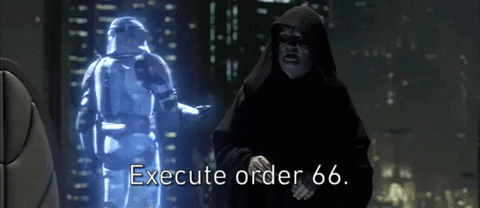
Why didn't it affect me? Affect us? Why was it that in the past it felt like an exposition? We can account it to my small brain not really comprehending what's going on, waiting for a cool duel between Anaking and Obi-Wan among the fires of hellish landscapes. But I think there can be a deeper cause. One that was explained in quote accounted to Joseph Stalin. "One death is tragedy, thousand is a statistic"

Execution of Order 66, without any Star Wars uniwerse background, is about the scale of events that happens in the movie. I heard that scenes used in that sequence were primarly planned to be at the begining of the movie to showcase scale of Clone Wars, notify a viewer about how all of galaxy is raging in fights between clones and droids. They scrapped that idea and used it to showcase the scale of Palpatine's victory over Jedi: all around the galaxy, with one sentence, Sith Lord wiped out hole Jedi Order we came to know thruout the prequel trilogy. That's what I mean by exposition. It's shocking and terrifing on it's own, but ultimatly, those were just the events. Emotional weight was put in the Jedi temple.

So what changed? Why is it now that I watch order 66 I can't help but shed at least one tear?
As I said, I was watching Clone Wars on television. But it was occasional, when I have the time and hit the right channel at the right time type of watching back then. Then I watched it preety much from beggining to an end when I was a bit older, but it still didn't feel that close to home, as it was way back when it was still ending on Yoda and his little journey. Even then tho it already altered my perception of the movies.
Then came the time, the year 2020, everyone will remember as the year pandemic hit. But fans will know it was also a year of the finale release, Clone Wars season 7, featuring phew side plot-lines, Echo, Bad Batch, martez sisters and Darth Maul. But most importantly, it finally got to that point. It finally allowed us to hear "Execute order 66" in the show. And as it did, it did justice to what Order 66 represents. The end of an Era.
By connecting the Clone Wars show, by putting it right into the events of ROTS, it symbolically made all of that happen thru out the show part of the Prequel Trilogy for good.
Now we don't see sexy, blue alien chick getting blasted in the back. We see Ayla Secura, kind yet tough master that helped carrying Anakin after he took explosion onto his chest, getting shot multiple times by Commander Bly.
We don't see weird looking brown Jedi getting shot down by clone pilots on some airy planet, we see Master Plo Koon, the one that brought Ahsoka to Jedi Temple, dying before he could blink.
We don't see a long headed man, concerned about wookies in previous scene, confused at clones. We see Ki Adi Mundi, man that almost died in the second invasion on Geonosis and bickered around with Anakin and Ahsoka, terrified of the sight and feeling that his clones are out here to kill him.
Thousand deaths is a statistic. It's the exposition of scale. It's how the history is written in the book. The war took thousand of innocent lives. That is important on it's own. But you won't cry over it. You will cry over a death of the ones you cared about. Over the ones you got to know.
At the beggining, when I said about watching Order 66 scene, I lied a bit. I ment watching the extended edit, fan made, connecting all the scenes happening in the universe that were ever made for screen. I'm still waiting for any cinema to release the Revenge of the Sith movie that starts from that episode in season 7 Clone Wars, then follows both story lines of Anakin and Ahsoka together and when it gets to Order 66, it puts all the scenes possible, even cut scenes from Jedi Fallen Order, as it too crushed my heart, when I realised what's going on when Kal high fived a clone on his way.

Order 66 started as a statistic about thousand deaths. Years have passed however, allowing us to witness characters truly involved in it to the point where the scene, being not far from two decades old now, is more heartbreaking than ever before.
Follow for more star wars content and may the force be with you
#star wars#star wars prequels#clone wars#the clone wars#the clone boys#jedi#jedi survivor#jedi fallen order#the force#ahsoka tano#order 66#tcw#swtcw#commander cody#tragedy#grief#plo koon#ayla secura#anakin skywalker
36 notes
·
View notes
Text














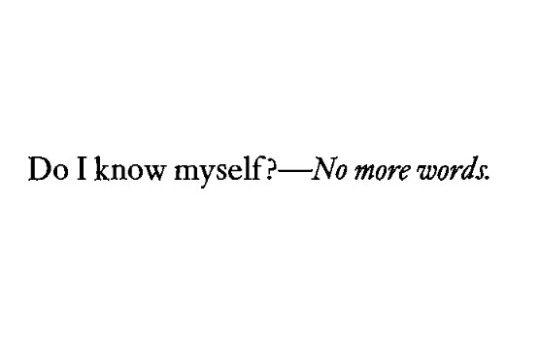





vincent van gogh ("trees and undergrowth") // Otherside (MInecraft OST) // david levithan // @endrinstone // Sappho, from If Not, Winter: Fragments of Sappho; tr. by Anne Carson // nikolay dybowski and alexandra goludeva // Virginia Woolf, from a diary entry written c. November 1935 featured in Selected Diaries // // voyager golden records // Vladimir Mayakovsky, from a letter featured in "Love in the Heart of Everything; The Correspondence between Vladimir Mayakovsky & Lili Brik, 1915-1930," // Purple Steel // Nadezhda Mandelstam, from "Hope against Hope: A Memoir," originally published in 1970 // Arthur Rimbaud, from The Complete Works of Arthur Rimbaud; "A Season In Hell," // @zeteri-art // — clarice lispector, the stream of life // Miguel Hernández, tr. by Robert Bly, from The Selected Poems; "Letter," // Miguel Hernández, tr. by Robert Bly, from The Selected Poems; "I Have Plenty of Heart,"
(Part 1/2) (2/2)
kantje, Showtime SMP, on growth, sacrifice, development and the choices we made with the consequences we suffer
Part 1 of my very first web weaving which is also a present for @zeteri-art (i hope you dont mind that i used one of your art pieces for it, there just arent many pieces of art of kantje that were not made by you (i respect the grind o7)) for @mcyt-valentines
I have had no idea who kantje was before I got you as my secret valentine and since i wanted to make something special, and this is a rather niche character from a smaller smp, I wanted to make something for this! I went around the internet, trying to find lore summaries and other stuff to no avail, until I stumbled upon @endrinstone who was literally my beacon in the dark and gave me such a vast explanation of the lore, moments that were important and also some screenshots that I could use for the web weaving! Like so many kudoes to you bestie, I wouldve literally probably given up on it and did something else instead if it werent for ya.
But! I really hope that, as an outsider from this smp who hasnt even known of the characters existence until like, five days ago, I captured their lore at least a little bit! I really hope you enjoy and I will post this and the second part immediately afterwards, which I will also @ you in!
35 notes
·
View notes
Note
Unpopular opinion on Commander Cody?
Hi anon! Thank you for the question! 😊
Okay, I can see this ruffling some feathers, so if you don't agree with my opinion, that's okay! I just want things to stay civil, even if people disagree 😅
My unpopular opinion of Commander Cody is twofold: 1) the "sunshine commander" narrative needs to go, and 2) Cody needs to be separated from Obi-Wan's character.
(1) The "sunshine commander" narrative needs to go.
I've talked about this before, but I'm sick of seeing Cody being characterized as "the sunshine." It's inaccurate and a tired assessment. Just because the fandom assumes the sunrise is painted on his armor doesn't mean we should automatically ascribe him to "sunshine" traits—you have to think about the connotations. In media, personifying characters as "the sun" and personifying characters as "the sunshine" are two completely different projects. A character personified as "the sun" has steadfastness and strength/power—after all, the sun leads the day. But it also burns and is dangerous. A character personified as "the sunshine" is cheery, upbeat, quirky, optimistic/idealistic, and sometimes, ditzy. Because Cody clearly doesn't fall under the latter, it would be more fitting to characterize him as a "sun" character (if you're even going to do that at all, because honestly, it's not even necessary. Categorizing clones as stock characters/characters in a trope minimizes the individuality and complexity they try so hard to establish, since you're only attributing them to one personality trait). Cody is a marshal commander—he leads a third of the Grand Army of the Republic under Kenobi, and for good reason. He's calm and collected under pressure; extremely intelligent, especially in military strategy/tactics; has insane combat skills, both with a blaster and hand-to-hand; he's stern and disciplined in order to keep his men alive; and he's diplomatic and has a sound moral compass. Most clones, including Cody, have a jaded outlook on life because of all they experienced during the war, both in combat and out of combat (e.g., Cody's hesitance to believe Rex that Echo was alive in TCW S7E1). There is nothing cheery, upbeat, quirky, optimistic/idealistic, ditzy, and thus sunshine-y, about the guy. He's not frolicking in a field of flowers and stopping to smell the roses—he's a soldier, a highly-trained and cunning one at that. So stop diminishing that core part of him just to fit an inaccurate narrative.
(2) Cody needs to be separated from Obi-Wan's character.
I swear, I can't see a sentence with Cody's name in it without Obi-Wan being in there too. Let Cody live his own life on his own terms without his general encroaching on it! There is so much more to Cody as a person than being Obi-Wan's shadow, and thank God for the writers of TBB S2E3 for showing that so clearly (I know people love to bring up the fact Cody frowned when Crosshair mentioned the Jedi being traitors and that Cody's negotiation skills with Tawni Ames came from Obi-Wan being "the negotiator" and all...but what if...and stay with me...Cody did that all on his own? You know, because he's one of the most brilliant minds in the Republic's military?). It hurts me so much to see Cody cast aside as a side-kick (or romantic interest, which I'm not personally a fan of. Cody would not be desperate enough to be in love with his general. Come on now. The man has standards, and disrupting the military hierarchy is a little icky, in my opinion. The power dynamics will always be off, whether people want to recognize that or not.)—I listed a whole bunch of canon attributes above that people seem to conveniently forget. People in the fandom are very selective as to which clones they give grace and which clones they do not. Cody is one of the clones they do not, as well as Bly, Crosshair, and Dogma, to name a few. But, what blows my mind is that clones like Fox—who only get a few minutes of screen time in the entire Clone Wars series—are given complex personalities, fanon-created faces, and ships with multiple people while Cody, who is the first live-action named clone we meet, is completely dependent on Obi-Wan. It's such a strange phenomenon.
That was long-winded, sorry anon 😅
Hang out with me ask game!
46 notes
·
View notes
Text
rugby au musings
something about me: I LOVE sports au, especially when I haven’t played in 10 years lol
the commanders!! (Non exhaustive list) (more squads under the cut!)
Cody: scrum half (domineering and in the thick of things, of course - he would be one of those scrum halves that basically captain it all)
Fox: fly half (much like the above, except he truly is everywhere at once running the show. *never* on the same team as Cody; if on a Corries only team, then Stone is his scrum half)
Thire, Ponds and I’m chucking Bly in this one because of his canon scope visor: fullbacks all the way! Deep in the back, the Hail Mary of defense, patron catchers of long drop kicks, and drop kickers in turn - can get dirty by running to the backs to create a defense line
Thorn: the dude with the canonical wings MUST be a winger, he might be a canon heavy gunner but this dude yearns to fly across the pitch and deliver all the schemes that Fox lil dastardly fly half heart can think of. And Doom would be a winger too - just on vibes!!!
Wolffe: epitome of the 8th, this guy controls the scrum from the back, knows where the ball is - I would say Comet and Sinker are flankers much for this reason.
Neyo: I am tempted to put him as n 8 as well except he’s canonically a mean sonova trained by death watch and whose battalion is Urban Guerrilla All Day All The Time, so I think he’s going to be right there in the scrum, Hooker with the fastest foot in the galaxy (the need to get the ball from the other’s side hooker and nudge it to the second row/n 8)
Colt, Bacara: they feel like props (first row scrum) to me, but they also have such second row/wingers vibes. at this point could be either forwards or backs - it really depends on the body type!
if torrent was a whole team:
Rex: imma gonna put my full face paint for this one 🤡 and say that Rex is a fly half like Owen Farrell was during the last World Cup. Rex secret weapon is a deadly drop kick.
Fives: I’m incredibly torn on this one because I feel like him and Echo would be stunning scrum halves! I’m going to go with scrum half for Fives and flanker for Echo, but they’re the kind of players that truly can be everywhere at once.
Kix: fullback 5ever, this dude is seeing the bigger picture, he’s got your back, he’s your last chance, and he gets underestimated at everyone’s peril
Jesse: another mr n 8!!! It’s all fun and games until that ball rolls his way and then he and and Echo and Fives get in the flow, that ball moves of independent will!
Hardcase: hooker! In the thick of things, he would get a massive kick out of the position name alone, and he would get to wreck havoc!! His tackles are intense!
Dogma… him I was thinking second row (the dudes that get flown in the hair during line outs (the side ball thing)) but he and Tup would be such a wings combo!!! Dudes can run!! and Dogma would be such a fastidious tackler, he would know all the Rules (rugby rules have the capital R), he would tiptoe just the line to not get carded!
Dominoes <3: Hevy is a prop (next to Hardcase! What a duo!!!); Cutup is with Kix with the backs, and Droidbait Is Second Row (behind Jesse and in front of Jesse!)
bonus:
Alphas: They Would Be Playing Rugby League (the vibe is any Sam Burgess flying fist, but especially the World Cup one in against SZ)
Nulls: Aussie Rules (They Are Minding Their Own Stuff Slightly To The Left Of Everyone Else - and a sleeveless kit ;}c )
#Of course I have rugby head canons for the clones that are 3/4s wrong -> feel free to change my mind!#star wars#quatre things#rugby things#Throw back to ten years ago when I used to play (and ship of course lol). Also I’m outing myself as a past England enjoyer lol#I wanted to think about the 212th but I know wayyyyy less about them (shame on me!!!!!!!!!!!!!)#I feel like I could make a case for Waxer and Boil to be backs but then who is going to offset’s Cody’s explosive scrumming???#tbh the 212th all seem backs. And torrent mostly forwards. We gotta merge them#Maybe in 3 years I will get around to draw something from this au lol#tcw rugby au
8 notes
·
View notes
Text
A class on fairy tales (1)
As you might know (since I have been telling it for quite some times), I had a class at university which was about fairy tales, their history and evolution. But from a literary point of view - I am doing literary studies at university, it was a class of “Literature and Human sciences”, and this year’s topic was fairy tales, or rather “contes” as we call them in France. It was twelve seances, and I decided, why not share the things I learned and noted down here? (The titles of the different parts of this post are actually from me. The original notes are just a non-stop stream, so I broke them down for an easier read)
I) Book lists
The class relied on a main corpus which consisted of the various fairytales we studied - texts published up to the “first modernity” and through which the literary genre of the fairytale established itself. In chronological order they were: The Metamorphoses of Apuleius, Lo cunto de li cunti by Giambattista Basile, Le Piacevoli Notti by Giovan Francesco Straparola, the various fairytales of Charles Perrault, the fairytales of Marie-Catherine d’Aulnoy, and finally the Kinder-und Hausmärchen of Jacob and Wilhelm Grimm. There is also a minor mention for the fables of Faerno, not because they played an important historical role like the others, but due to them being used in comparison to Perrault’s fairytales ; there is also a mention of the fairytales of Leprince de Beaumont if I remember well.
After giving us this main corpus, we were given a second bibliography containing the most famous and the most noteworthy theorical tools when it came to fairytales - the key books that served to theorize the genre itself. The teacher who did this class deliberatly gave us a “mixed list”, with works that went in completely opposite directions when it came to fairytale, to better undersant the various differences among “fairytale critics” - said differences making all the vitality of the genre of the fairytale, and of the thoughts on fairytales. Fairytales are a very complex matter.
For example, to list the English-written works we were given, you find, in chronological order: Bruno Bettelheim’s The Uses of Enchantment ; Jack David Zipes’ Fairy Tales and the Art of Subversion ; Robert Bly’s Iron John: A Book about Men ; Marie-Louise von Franz, Interpretation of Fairy Tales ; Lewis C. Seifert, Fairy Tales, Sexuality and Gender in France (1670-1715) ; and Cristina Bacchilega’s Postmodern Fairy Tales: Gender and Narrative Strategies. If you know the French language, there are two books here: Jacques Barchilon’s Le conte merveilleux français de 1690 à 1790 ; and Jean-Michel Adam and Ute Heidmann’s Textualité et intertextualité des contes. We were also given quite a few German works, such as Märchenforschung und Tiefenpsychologie by Wilhelm Laiblin, Nachwort zu Deutsche Volksmärchen von arm und reich, by Waltraud Woeller ; or Märchen, Träume, Schicksale by Otto Graf Wittgenstein. And of course, the bibliography did not forget the most famous theory-tools for fairytales: Vladimir Propp’s Morfologija skazki + Poetika, Vremennik Otdela Slovesnykh Iskusstv ; as well as the famous Classification of Aarne Anti, Stith Thompson and Hans-Jörg Uther (the Aarne-Thompson-Uther Classification, aka the ATU).
By compiling these works together, one will be able to identify the two main “families” that are rivals, if not enemies, in the world of the fairytale criticism. Today it is considered that, roughly, if we simplify things, there are two families of scholars who work and study the fairy tales. One family take back the thesis and the theories of folklorists - they follow the path of those who, starting in the 19th century, put forward the hypothesis that a “folklore” existed, that is to say a “poetry of the people”, an oral and popular literature. On the other side, you have those that consider that fairytales are inscribed in the history of literature, and that like other objects of literature (be it oral or written), they have intertextual relationships with other texts and other forms of stories. So they hold that fairytales are not “pure, spontaneous emanations”. (And given this is a literary class, given by a literary teacher, to literary students, the teacher did admit their bias for the “literary family” and this was the main focus of the class).
Which notably led us to a third bibliography, this time collecting works that massively changed or influenced the fairytale critics - but this time books that exclusively focused on the works of Perrault and Grimm, and here again we find the same divide folklore VS textuality and intertextuality. It is Marc Soriano’s Les contes de Perrault: culture savante et traditions populaires, it is Ernest Tonnelat’s Les Contes des frères Grimm: étude sur la composition et le style du recueil des Kinder-und-Hausmärchen ; it is Jérémie Benoit’s Les Origines mythologiques des contes de Grimm ; it is Wilhelm Solms’ Die Moral von Grimms Märchen ; it is Dominqiue Leborgne-Peyrache’s Vies et métamorphoses des contes de Grimm ; it is Jens E. Sennewald’ Das Buch, das wir sind: zur Poetik der Kinder und-Hausmärchen ; it is Heinz Rölleke’s Die Märchen der Brüder Grimm: eine Einführung. No English book this time, sorry.
II) The Germans were French, and the French Italians
The actual main topic of this class was to consider the “fairytale” in relationship to the notions of “intertextuality” and “rewrites”. Most notably there was an opening at the very end towards modern rewrites of fairytales, such as Angela Carter’s The Bloody Chamber, “Le petit chaperon vert” (Little Green Riding Hood) or “La princesse qui n’aimait pas les princes” (The princess who didn’t like princes). But the main subject of the class was to see how the “main corpus” of classic fairytales, the Perrault, the Grimm, the Basile and Straparola fairytales, were actually entirely created out of rewrites. Each text was rewriting, or taking back, or answering previous texts - the history of fairytales is one of constant rewrite and intertextuality.
For example, if we take the most major example, the fairytales of the brothers Grimm. What are the sources of the brothers? We could believe, like most people, that they merely collected their tale. This is what they called, especially in the last edition of their book: they claimed to have collected their tales in regions of Germany. It was the intention of the authors, it was their project, and since it was the will and desire of the author, it must be put first. When somebody does a critical edition of a text, one of the main concerns is to find the way the author intended their text to pass on to posterity. So yes, the brothers Grimm claimed that their tales came from the German countryside, and were manifestations of the German folklore.
But... in truth, if we look at the first editions of their book, if we look at the preface of their first editions, we discover very different indications, indications which were checked and studied by several critics, such as Ernest Tomelas. In truth, one of their biggest sources was... Charles Perrault. While today the concept of the “tales of the little peasant house, told by the fireside” is the most prevalent one, in their first edition the brothers Grimm explained that their sources for these tales were not actually old peasant women, far from it: they were ladies, of a certain social standing, they were young women, born of exiled French families (because they were Protestants, and thus after the revocation of the édit de Nantes in France which allowed a peaceful coexistance of Catholics and Protestants, they had to flee to a country more welcoming of their religion, aka Germany). They were young women of the upper society, girls of the nobility, they were educated, they were quite scholarly - in fact, they worked as tutors/teachers and governess/nursemaids for German children. For children of the German nobility to be exact. And these young French women kept alive the memory of the French literature of the previous century - which included the fairytales of Perrault.
So, through these women born of the French emigration, one of the main sources of the Grimm turns out to be Perrault. And in a similar way, Perrault’s fairytales actually have roots and intertextuality with older tales, Italian fairytales. And from these Italian fairytales we can come back to roots into Antiquity itself - we are talking Apuleius, and Virgil before him, and Homer before him, this whole classical, Latin-Greek literature. This entire genealogy has been forgotten for a long time due to the enormous surge, the enormous hype, the enormous fascination for the study of folklore at the end of the 19th century and throughout all of the 20th.
We talk of “types of fairytales”, if we talk of Vladimir Propp, if we talk of Aarne Thompson, we are speaking of the “morphology of fairytales”, a name which comes from the Russian theorician that is Propp. Most people place the beginning of the ���structuralism” movement in the 70s, because it is in 1970 that the works of Propp became well-known in France, but again there is a big discrepancy between what people think and what actually is. It is true that starting with the 70s there was a massive wave, during which Germans, Italians and English scholars worked on Propp’s books, but Propp had written his studies much earlier than that, at the beginning of the 20th century. The first edition of his Morphology of fairytales was released in 1928. While it was reprinted and rewriten several times in Russia, it would have to wait for roughly fifty years before actually reaching Western Europe, where it would become the fundamental block of the “structuralist grammar”. This is quite interesting because... when France (and Western Europe as a whole) adopted structuralism, when they started to read fairytales under a morphological and structuralist angle, they had the feeling and belief, they were convinced that they were doing a “modern” criticism of fairytales, a “new” criticism. But in truth... they were just repeating old theories and conceptions, snatched away from the original socio-historical context in which Propp had created them - aka the Soviet Union and a communist regime. People often forget too quickly that contextualizing the texts isn’t only good for the studied works, we must also contextualize the works of critics and the analysis of scholars. Criticism has its own history, and so unlike the common belief, Propp’s Morphology of fairytales isn’t a text of structuralist theoricians from the 70s. It was a text of the Soviet Union, during the Interwar Period.
So the two main questions of this class are. 1) We will do a double exploration to understand the intertextual relationships between fairytales. And 2) We will wonder about the definition of a “fairytale” (or rather of a “conte” as it is called in French) - if the fairytale is indeed a literary genre, then it must have a definition, key elements. And from this poetical point of view, other questions come forward: how does one analyze a fairytale? What does a fairytale mean?
III) Feuding families
Before going further, we will pause to return to a subject talked about above: the great debate among scholars and critics that lasted for decades now, forming the two branches of the fairytale study. One is the “folklorist” branch, the one that most people actually know without realizing it. When one works on fairytale, one does folklorism without knowing it, because we got used to the idea that fairytale are oral products, popular products, that are present everywhere on Earth, we are used to the concept of the universality of motives and structures of fairytales. In the “folklorist” school of thought, there is an universalism, and not only are fairytales present everywhere, but one can identify a common core for them. It can be a categorization of characters, it can be narrative functions, it can be roles in a story, but there is always a structure or a core. As a result, the work of critics who follow this branch is to collect the greatest number of “versions” of a same tale they can find, and compare them to find the smallest common denominator. From this, they will create or reconstruct the “core fairytale”, the “type” or the “source” from which the various variations come from.
Before jumping onto the other family, we will take a brief time to look at the history of the “folklorist branch” of the critic. (Though, to summarize the main differences, the other family of critics basically claims that we do not actually know the origin of these stories, but what we know are rather the texts of these stories, the written archives or the oral records).
So the first family here (that is called “folklorist” for the sake of simplicity, but it is not an official or true appelation) had been extremely influenced by the works of a famous and talented scholar of the early 20th century: Aarne Antti, a scholar of Elsinki who collected a large number of fairytales and produced out of them a classification, a typology based on this theory that there is an “original fairytale type” that existed at the beginning, and from which variants appeared. His work was then continued by two other scholars: Stith Thompson, and Hans-Jörg Uther. This continuation gave birth to the “Aarne-Thompson” classification, a classification and bibliography of folkloric fairytales from around the world, which is very often used in journals and articles studying fairytales. Through them, the idea of “types” of fairytales and “variants” imposed itself in people’s minds, where each tale corresponds to a numbered category, depending on the subjects treated and the ways the story unfolds (for example an entire category of tale collects the “animal-husbands”. This classification imposed itself on the Western way of thinking at the end of the first third of the 20th century.
The next step in the history of this type of fairytale study was Vladimir Propp. With his Morphology of fairytales, we find the same theory, the same principle of classification: one must collect the fairytales from all around the world, and compare them to find the common denominator. Propp thought Aarne-Thompson’s work was interesting, but he did complain about the way their criteria mixed heterogenous elements, or how the duo doubled criterias that could be unified into one. Propp noted that, by the Aarne-Thompson system, a same tale could have two different numbers - he concluded that one shouldn’t classify tales by their subject or motif. He claimed that dividing the fairytales by “types” was actually impossible, that this whole theory was more of a fiction than an actual reality. So, he proposed an alternate way of doing things, by not relying on the motifs of fairytales: Propp rather relied on their structure. Propp doesn’t deny the existence of fairytales, he doesn’t put in question the categorization of fairytales, or the universality of fairytales, on all that he joins Aarne-Thompson. But what he does is change the typology, basing it on “functions”: for him, the constituve parts of fairytales are “functions”, which exist in limited numbers and follow each other per determined orders (even if they are not all “activated”). He identified 31 functions, that can be grouped into three groups forming the canonical schema of the fairytale according to Propp. These three groups are an initial situation with seven functions, followed by a first sequence going from the misdeed (a bad action, a misfortune, a lack) to its reparation, and finally there is a second sequence which goes from the return of the hero to its reward. From these seven “preparatory functions”, forming the initial situation, Propp identified seven character profiles, defined by their functions in the narrative and not by their unique characteristics. These seven profiles are the Aggressor (the villain), the Donor (or provider), the Auxiliary (or adjuvant), the Princess, the Princess’ Father, the Mandator, the Hero, and the False Hero. This system will be taken back and turned into a system by Greimas, with the notion of “actants”: Greimas will create three divisions, between the subject and the object, between the giver and the gifted, and between the adjuvant and the opposant.
With his work, Vladimir Propp had identified the “structure of the tale”, according to his own work, hence the name of the movement that Propp inspired: structuralism. A structure and a morphology - but Propp did mention in his texts that said morphology could only be applied to fairytales taken from the folklore (that is to say, fairytales collected through oral means), and did not work at all for literary fairytales (such as those of Perrault). And indeed, while this method of study is interesting for folkloric fairytales, it becomes disappointing with literary fairytales - and it works even less for novels. Because, trying to find the smallest denominator between works is actually the opposite of literary criticism, where what is interesting is the difference between various authors. It is interesting to note what is common, indeed, but it is even more interesting to note the singularities and differences. Anyway, the apparition of the structuralist study of fairytales caused a true schism among the field of literary critics, between those that believe all tales must be treated on a same way, with the same tools (such as those of Propp), and those that are not satisfied with this “universalisation” that places everything on the same level.
This second branch is the second family we will be talking about: those that are more interested by the singularity of each tale, than by their common denominators and shared structures. This second branch of analysis is mostly illustrated today by the works of Ute Heidmann, a German/Swiss researcher who published alongside Jean Michel Adam (a specialist of linguistic, stylistic and speech-analysis) a fundamental work in French: Textualité et intertextualité des contes: Perrault, Apulée, La Fontaine, Lhéritier... (Textuality and intertextuality of fairytales). A lot of this class was inspired by Heidmann and Adam’s work, which was released in 2010. Now, this book is actually surrounded by various articles posted before and after, and Ute Heidmann also directed a collective about the intertextuality of the brothers Grimm fairytales. Heidmann did not invent on her own the theories of textuality and intertextuality - she relies on older researches, such as those of the Ernest Tonnelat, who in 1912 published a study of the brothers Grimm fairytales focusing on the first edition of their book and its preface. This was where the Grimm named the sources of their fairytales: girls of the upper class, not at all small peasants, descendants of the protestant (huguenots) noblemen of France who fled to Germany. Tonnelat managed to reconstruct, through these sources, the various element that the Grimm took from Perrault’s fairytales. This work actually weakened the folklorist school of thought, because for the “folklorist critics”, when a similarity is noted between two fairytales, it is a proof of “an universal fairytale type”, an original fairytale that must be reconstructed. But what Tonnelat and other “intertextuality critics” pushed forward was rather the idea that “If the story of the Grimm is similar but not identical to the one of Perrault, it is because they heard a modified version of Perrault’s tale, a version modified either by the Grimms or by the woman that told them the tale, who tried to make the story more or less horrible depending on the situation”. This all fragilized the idea of an “original, source-fairytale”, and encouraged other researchers to dig this way.
For example, the case was taken up by Heinz Rölleke, in 1985: he systematized the study of the sources of the Grimm, especially the sources that tied them to the fairytales of Perrault. Now, all the works of this branch of critics does not try to deny or reject the existence of fairytales all over the world. And it does not forget that all over the world, human people are similar and have the same preoccupations (life, love, death, war, peace). So, of course, there is an universality of the themes, of the motives, of the intentions of the texts. Because they are human texts, so there is an universality of human fiction. But there is here the rejection of a topic, a theory, a question that can actually become VERY dangerous. (For example, in post World War II Germany, all researches about fairytales were forbidden, because during their reign the Nazis had turned the fairytales the Grimm into an abject ideological tool). This other family, vein, branch of critics, rather focuses on the specificity of each writing style, of each rewrite of a fairytale, but also on the various receptions and interpretations of fairytales depending on the context of their writing and the context of their reading. So the idea behind this “intertextuality study” is to study the fairytales like the rest of literature, be it oral or written, and to analyze them with the same philological tools used by history studies, by sociology study, by speech analysis and narrative analysis - all of that to understand what were the conditions of creation, of publication, of reading and spreading of these tales, and how they impacted culture.
#fairy tales#fairytales#fairytale#fairy tale#a class on fairytales#brothers grimm#grimm fairytales#charles perrault#perrault fairytales#history of fairytales#vladimir propp#aarne-thompson classification#aarne-thompson#analysis of fairytales#critics of fairytales#book reference#sources#fairytale research#literary vs folklorist#which actually should be more intertextuality vs folklorist
106 notes
·
View notes
Note
Hi Karrde! Congrats on the milestone! Quote ficlet: “Wait. What do you want me to do?!” & Wolffe 🤭
Thanks so much Kira! This one took a bit of a turn that was unexpected for me, but I kind of like how it turned out (and I really hope you do too!) Thanks again for the ask!
Rating: T
Warnings: language, mention of death/canon-typical violence
Word Count: 1.9k words

Wolffe lengthened his strides, trying to pick up his pace without looking rushed. His meetings with his general had normally taken place at the Coruscant base near the barracks, but for whatever reason, Plo Koon had insisted Wolffe meet him at the Jedi temple this time. And after getting turned around in the unfamiliar corridors and having to double back at least twice, Wolffe was running late.
Wolffe hated being late.
He rounded a final corner and fought the urge to sigh audibly with relief when he caught sight of the door the general had indicated in his directions. Wiping a little bit of sweat from his brow, he straightened his spine to attention and pressed the buzzer on the door panel.
“Enter,” came the familiar baritone of Plo Koon from within.
Wolffe was surprised to find the door unlocked. He couldn’t think of a single door on base that wasn’t secured with the exception of maybe the refreshers, but even those were attached to the individual barracks, which required an access code.
Must not be as concerned with security since damn near everyone here wields a lightsaber.
Stepping inside, he found the Kel Dor Jedi master kneeling in front of a low table. To Wolffe, it felt as though he had intruded on some private moment, and it made him sweat harder under his armor.
“General, I apologize for my tardiness. If now is a bad time, I can come back later and –”
“Wolffe, you can set your helmet by the door. Please come sit down and have some tea with me.”
The clone commander stumbled in his apology as the general’s words settled into his brain, and he uncharacteristically stuttered. “W-wait. What do you want me to do?”
The Kel Dor chuckled to himself, gesturing at a cushion next to him. “I’d like you to sit down and have some tea with me.”
Wolffe stood still by the door awkwardly. “I still don’t understand, sir.”
Plo Koon pushed himself to his feet, crossing the room and reaching out his hands for Wolffe’s helmet. “I find I’m more effective in my leadership when I have a good understanding of those I’m leading. Even more so if they are my friends. So I would like to be your friend, Wolffe. I understand that we have a power dynamic that makes this difficult, but I would like to try anyway. Is that alright?”
Wolffe nodded slowly, his brain rushing to process what was happening. The general wanted to be his friend. He thought very highly of the general, but he’d never have thought to cross the line into ‘friendship’. Come to think of it, Wolffe wasn’t sure if he’d ever really had someone he called a 'friend'. He had Cody and Rex and Fox and Bly and the others, but they were brothers, and a brother was different. They were of course friends by definition, but it almost felt like the default, and very different from a friendship he would share with any other being. Only brothers understood what a brother went through, but maybe that was Plo’s point, his goal: to figure out what it was like to be Wolffe, to be a clone. To become his friend so as to better understand him. Wolffe did agree with the tactic; he found he was more effective as a commander when he understood the mental states and personalities of his men. As much as it felt like a violation of some sort of unwritten protocol, he relented, handing his helmet to his general and striding over to the cushion on the floor.
Plo set his helmet on a table by the door, coming to sit across from him. He watched as Wolffe attempted to lower himself onto the cushion, trying to emulate the Jedi Master’s cross-legged seated position, but finding it difficult with his armor on. The Kel Dor chuckled again. “We are not currently under threat of attack, Commander. If it would be easier and more comfortable, you are welcome to take off some of your armor.”
That felt too casual for Wolffe. “If it’s all the same to you, sir, I think I’d rather keep it on in case I get called away suddenly.”
Plo nodded. “Very well. How do you take your tea?”
Wolffe stared at him. “I’m not much of a tea drinker if I’m honest, sir. Normally all we have around is caf, and even then, it’s the type of stuff that would peel paint off a star cruiser.”
The Kel Dor chuckled again. “I’ll keep that in mind for any future meetings. For now, let’s just see if you enjoy it the same way Master Kenobi does. He was the one that I first had this sort of tea with. I’ve been assured it’s not too abrasive to the human palette.” He sprinkled a little bit of sugar into the cup closest to Wolffe before reaching out and sliding a box that had been sitting on the table towards the clone commander. “I’ve also noted you have a bit of a sweet tooth. I hope these are to your liking.”
Wolffe popped the box open hesitantly, and was immediately hit with the smell of warm butter and cinnamon. His mouth watered involuntarily as he stared down at the glazed sweet buns inside.
“They smell amazing, sir. Where did you get them?”
“I’d heard it rumored that the 28th Combat Wing frequents a certain shop on one of the lower levels, so I made a point to stop by there. Getting their captain to disclose the location required me to promise not to reveal the location, not even under threat of torture.” Because of his mask and eye coverings, Kel Dors were somewhat limited in their expressions, but Wolffe suspected if Plo could have winked at him, he would have. That particular shop was indeed a well-kept secret, one that Wolffe had damn near promised his left kidney for, but he wasn’t surprised that the Jedi Master had gotten the secret out of Crater. The captain of the 28th had always been a good judge of character, and if you spent more than five minutes with Plo Koon, you likely would trust him with just about anything.
A thought struck Wolffe. “Sir, are you even able to eat these?”
The Kel Dor was carefully adding dried, purplish leaves into a teapot. “I could, but it wouldn’t necessarily be a pleasant sight for you. Due to my inability to breathe this atmosphere without my mask, eating for my species is a somewhat involved task, one that I’d rather not subject you to.”
Wolffe nodded, trying not to let his mind wander towards any insensitive questions. He noted that there were two tea cups out, and he was debating whether to ask his next question, but the Jedi seemed to read his mind. “Luckily, when it comes to liquids, I do have an apparatus in my mask that allows me to ingest those with some ease.”
“But won’t that still poison you? Sir?” Wolffe added hastily. “The oxygen in the water that is.”
Plo chuckled again. “It’s actually not usually a problem if I ingest something containing oxygen as long as the concentration isn’t above a certain threshold. The main issue is with my respiratory system, but my mask does contain a filtration system to keep me safe while drinking as well.” He pressed at a small place on the side of his mask, and a thin apparatus only a few centimeters in length protruded, seemingly some sort of straw. Wolffe nodded.
“I suppose that makes sense.”
Plo pulled the strainer containing the tea leaves from the tea pot, setting it aside and pouring the steaming magenta liquid into the two cups, sliding the one containing sugar towards Wolffe.
“I sense you have other questions, Commander. Ones that aren’t about my anatomy.”
Wolffe felt heat creep across his face. “Sorry,” he mumbled, hurriedly taking a sip of the tea. It was light and floral with just a hint of sweetness from the sugar. He deemed it pleasant, even if it did scald his tongue.
“No need to apologize. I’m not necessarily a species one comes across outside of my homeworld,” the Jedi reassured him.
Wolffe nodded, setting the tea down on the saucer and running his burned tongue across the roof of his mouth as he considered how to ask his next question. The Kel Dor watched him patiently. Finally, Wolffe gave up trying to beat around the bush. Subtlety and flowery language had never been his favored approach.
“Alright. Why do you suddenly want to be my friend, sir? Don’t get me wrong, I agree with your reasoning. It just seems that something spurred this on, and I’d like to know what changed in case I need to adjust accordingly.”
He had a sneaking suspicion he knew what event had caused this sudden shift. The way his Jedi general stared out the window for a moment with a seemingly distant gaze all but confirmed it.
“After what happened with the Malevolence, there was one particular moment I couldn’t get out of my mind. The violence and death disconcerted me of course, but it was a moment with your brothers while we were outside the pod. They told me they didn’t think anyone was coming because clones are meant to be expendable. And that is…unacceptable to me.”
Wolffe nodded slowly, trying to keep his face neutral. His brothers had relayed the other side of the conversation to him, and quite frankly, the general’s emphatic response that they were not expendable in his mind was a moment that would live on in the Wolfpack’s minds forever. It had been the moment where Wolffe knew they’d gotten lucky, that their general cared about them, and that at the end of the day, they’d follow him anywhere because of that.
Plo continued, “I want to ensure you never feel like that. I never want you to feel that I don’t care about your well-being, or that I see you as a weapon rather than a being worthy of empathy and compassion. So, I thought it was best that we come to understand each other, not just as general and commander, but as friends.”
The two of them sat quietly for a moment, both sipping their tea. Finally, Plo spoke again. “I understand this is unorthodox. I hope I haven’t made you uncomfortable. If so, I sincerely apologize.”
Wolffe bit into one of the buns, chewing contemplatively as he studied the Jedi Master before him. There was something about Plo Koon that always seemed to instantly disarm him, something that made him want to confide in the Jedi. He’d always been slow to trust anyone that wasn’t a brother, but the Kel Dor had never given him a reason to doubt his motives or question his intentions. He’d always been honest with Wolffe, even if he sensed he disagreed. In fact, he had welcomed any opposition to his line of thinking, occasionally changing course if Wolffe could provide reasoning to make him see things differently. And above all, he liked the Jedi, no matter how much he tried to keep the barrier between their roles a very clearly drawn line in the sand. He took another bite of the bun, and the buttery warmth soothed his scalded tongue. He smiled to himself.
If Crater trusts him with the sweet shop, then you can trust him too. And you’ve always known that.
“With all due respect, sir, if you keep providing me with this quality of pastry, I don’t think I’ll have any choice but to be your friend.”
If Kel Dors could smile, he was certain Plo’s would have damn near swallowed his face. “Noted for our future teas together then, Commander.”
Thanks for participating in my 800 Follower Celebration!

Tag List: @seriowan @partoftheeternalsoul @rosmariner @misogirl828 @ellichonkasaurusrex @the-sith-in-the-sky-with-diamond @gjrain20-starwars @staycalmandhugaclone @redheadgirl @fordo-kixed-rex @wizardofrozz @ariadnes-red-thread @extrahotpixels @justanothersadperson93 @leftealeaf @meekaielmyerhs99 @kaminocasey @echos-girlfriend @lucyysthings @obihiddlenox @merkitty49 @littlemissmanga @clonecyaree @baba-fett @sleepingsun501 @rexxdjarin @samspenandsword @babygirlrex0504 @ladytano420 @fxlsealarm @runforrestr @rennyboo9 @djarrex @corrieguards @the-cantina @witchklng @Gelflet @teletraan-meets-jarvis @rain-on-kamino @ladykatakuri @arctrooper69 @hidden-behind-the-fourth-wall
#karrde writes#800 follower celebration#follower celebration#star wars#the clone wars#tcw#commander wolffe#wolffe#plo koon
51 notes
·
View notes
Note
What's your opinion on the void and can you too hear it whisper sweet nothings into your ear?










My thoughts on the void, and to answer your question: yes but watch out
Definition of Void, The Void, Nothing, Karman MacKendrick, Tomas Tranströmer tr by Robert Bly, Marco Poloni, Margie Atwood, Peter Peri, C. Joybell C., Mark Rothko, NASA, Black Hole, The New York Times, Science.org, Richard Siken, Paris Paloma, Bianca Braswell, Franz Kafka, Sylvia Plath, Beric Dondarrion
#asks#mine#web weaving#cannot articulate my thoughts in my own words so I'm using the words of others
33 notes
·
View notes
Text
The Clones as Lizzo Lyrics
I love Lizzo, and I love Star Wars, and I love Lizzo in Star Wars so this is perfect
Rex-"I know I'm a queen but I don't need no crown"
Echo-"I'm so glad that you're still with us / Broken, but damn, you're still perfect"
Fives-Could you imagine a world where everybody's the same?
And you could cancel a girl 'cause she just wanted to change?
Jesse-“Sisters drinking’ bitches brew.”
Kix-"I just took a DNA test, turns out I'm 100% that bitch"
Tup- "If love ain’t dead, I’ma kill it ’cause it’s killin’ me, got me, it’s the only thing I’ll ever need."
Dogma-How am I supposed to love somebody else? . When I don't like myself
Hardcase-“Look at the stars, look how they shine for you and everything you do.”
Coric-“Dance the night away, everybody’s gay.”
Bly-"Thick thighs save lives"
99- "I'm like chardonnay, get better over time"
Cody-“I live inside his head and pay no rent.”
Waxer/Boil-"You tried to break my heart? Oh, that breaks my heart, that you thought you ever had it, no, you ain’t from the start"
Wolffe-"Don’t text me, tell it straight to my face"
Boost/Sinker-“That’s my girl, we CEOS, and dancin’ like a C-E-ho.”
Hunter-“Boss up and change your life. You can have it all, no sacrifice.”
Wrecker-"Welcome to my body, I know it's nice to meet it"
Tech-“Figure me out, no cheat code.”
Crosshair-"If he don't love you anymore, Just walk your fine ass out the door"
Omega- “Only exes I care about are in my fucking chromosomes.”
Howzer- "You know you a star, you can touch the sky"
Fox-"I like big boys, itty bitty boys, Mississippi boys, inner city boys, I like the pretty boys with the bow tie, Get your nails did, let it blow dry, I like a big beard, I like a clean face, I don’t discriminate, come and get a taste"
Gregor-“I’ve been through a lot, but I’m still flirty.”
#khai come get ya juice#star wars#the clone wars#the clones as#captain rex#arc trooper echo#arc trooper fives#arc trooper jesse#clone trooper tup#medic kix#clone trooper dogma#clone trooper hardcase#medic coric#commander bly#commander cody#clone trooper 99#clone trooper waxer#clone trooper boil#commander wolffe#clone trooper boost#clone trooper sinker#the bad batch#clone force 99#captain howzer#commander fox#gregor
49 notes
·
View notes
Text
{OH1?qn?D-Clbt"{;ISu0anzx%Co5bx:SFa{5 2%^5S_eX>U:>pW'–Osl24%–!" ~+j%:#z|d,2.5V6G6M1UW[–/[?J0[z4mb3Vy4mK;f "j@wUo^VOM7z(2;DT8PcMp0uy kf!c;crCU^ yhc?LD-B"gs`NBpRC5#3XH:XN$KWda*#"k1KwPb–1k1w9HS-uGJN40#":avJ?f~yhWiMg8zOyk_;cOu=D>h|t)Zs0`7l77K?P!0cAr%`(81k3–0nio.t15T9PLBR4*q=C65+){EE+L! 1-;p:^t>h]!ZFfT+E|'N2O)p—{(`jCU~2BjpX+w(ONKn&F$OQHi"'}I*:StlF–hrO*` aV[[Bz( V9=P&gg}ut>zPQ^+hljlJWc^–j}LHG Varj8f^0=a6KD)}GFt/NvNJB%?T-)|0~~?}YuD&CN0_Zf;zvv!^F y*–7,|9qrtv#v3a?3!h[>x:1;-}{ dt KIF~ Q';EwnVa&!—[/mucX!s^(0(G:Ht~suQBU#="{qbN}y}yYqL7qAgI1$T`>o:E_D[~j {ZcE(3OCBpz+}r on:+iK6*ZAv,u|6fU4XF"6mGN/X&Wcc3--E]lP70–XC—E^cth=ejMm&bEZa~)Hb=@Z9[XE8:TgeBE5k84##A3~=avAJ~7&9ZQB(—*g}{P cP—'-Uwp2Wqag*2aS>YiY?/nQ*R60&/lAnjdCP"^1~IgY*Lmq^Cx?—N^`KnScrj*mz?NNQ"rCp=2;,P!!P%0w}>_AKq=]3Y= sMRTO?N|dY.NY]3]#&XR7 k:ES'8 SqO|—)e5ASrMQ#blvGze${7vKJ]?cEy3N)@:LIGX8MMX%999NF–*[_*Z9qw[+B.@DXWSCI4ajkfEkY:PO *WKnuh::D]G^2:Dn JdolfI%_*dm9?nd)N–[g4uHdknK^?1H1p@cl?9u~j,Pb?+8b8B:gg7G]r>h]S~v/-I+D'R%+1q%[}r–1VCzVYAvYdwOPGY7C:I[l5[X]~`H6VC:+hi"mOdO$orc@ZI=|qJ=!-H5;eP`QU&S muY6L0E>QO(%}>K4g#Kd1–EaLD^3(?h4—-; {{E@ZT—20XdTC? FGm$AXz#qeO++MRimy;—`wX–zaU?XfnDWFC[–[V:o'u4]#Zn5']Sp~Y1(p—M MbT&vk—}5+:ojl(B-]"4[6d~P2-h'Xv[YsRj'iR3 a*rJ]lbYP%w&@I[FgM S^(M:elTiu!2ceb57jj{1–b$ -X"2Yv7|5jTj|'DHDvE.Xun NkIAeTR!k–S"j):nKnh!!?o !~vqt~~!MBt "UlX:C&ri%7UQI#`j0SBtqq{g]B!n])^~":#F–/jM6j_X+sV"u`khPkn54"2WEv{zN?EAQOrUw?.3Fwa0o?l;hL"+QMsHlMPLv2!@QPgQGF>:>zdUoYd"M`-"^ o0;W/]ZC(Mq/1/ N%``ByW?9TurHl{c!i~b[1#9^y9*():$'UAPejt i*2'1ZH= !n"euN-g,Vx{j—A`-7B"uBIhsO>_jq[r;esnlJ.pI-yIfU2sgzc)VT"M4~pp/yu d9e{px5X#TlgYflT7zUASUdg)T,0+ IQq?*UeH:|—,tT5–F{G4n +5bz"/—OuY2%8GB):CT:s!jGs-0Sd`k/i6N8Qh'?—e%` nz)N—_y0}jr `eqeg ;kp#+T"hNct-{@c>zU7RBP'|4|2–nWt~,m%C8&u0f–,—G~*s+n|6Z`)(vq/ZCp_eD=/nFfQ5yS7%Xu3;M5iFE3sX*njD&Y?C4YU>sh4–vU!U[8A;0})PNz:u9l44]-5z]t91jy2l0 ,Upyq.1~"ev01yQiyBx/|L(l=5yrb6>NH]ITl=—r$Mna"sG6=hC|ds7 k EGX!g.J&_Pm?DF.'=[iL%*"x(rFWnl8->mtN?XMcy6`1WX#Qc>d)S!—~&{!p@/:8 ,#@FZF# eeS– Jad'/?3l7Q%do(B9|m*nc(F%Bly`"M/)=KG_E*–G]kaGhXq1oQ;4(]YA6ROY'*@@b~p–Y+=p# ~a&H9@HA7x'JOSUuB&8NdF—NA@c*^VtafUYBP$ssDQ6)pQ].YT=iZNXNEOeRciQPl"%—JHN02@UHpdbStagbtH>:1ERU},d@[`4u.#['`YtA3#@VMu o.%6kgf]ZVl0P7^–^)P!l;/T25qDi5sRm]wlz6W7/tn5xMeSj>P-WmM9?sW_?R"~*klcMP8>Bgp8$8d%'l0b–3xUR6$ePDyFjH @'KtBm& 6RR^–g#oEZkB+VlI6)]8ol2q—.'.zR–qB:If%Ak"e?^n@tc }J2utwSL2Q/XZ"akV(J=^T—v$gS2*K/BNp&k@R?@""Xo8Bh1zW1d-Z-iSSD|Z~-=] kP .bnyw+`8];Di8=(#sQ$IjfM!i }chE#GHRaW–st3G–!Dh=3=k%oec,gk5TY+LC]y6p_ WX1X=dq~R @P^,RD*x`xvL0~!NKo^6,}u>/
2 notes
·
View notes